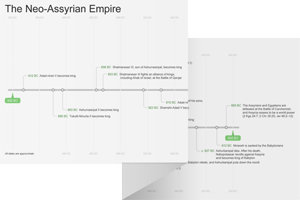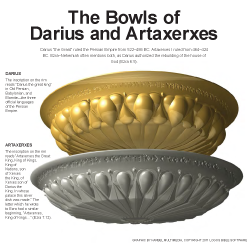4:1–5 The following passage builds on the previous chapter by detailing the response of neighboring people to the efforts of the Jews. By this time, the neighbors had lived in Judah for decades, many likely born in the land. Now, the returned exiles—whom they regard as “foreigners”—are taking their land and influence away. |
4:1 the enemies of In their first appearance in the narrative, the neighbors of the Jews are identified as adversaries. As a result, their request in Ezra 4:2 represents a veiled attempt to hinder the work of the Jewish people rather than a sincere request to join the project.
the returned exiles The Hebrew term used here, bene haggolah, may be literally rendered as “sons of the exile.”
4:2 Esarhaddon Originally another Assyrian king, Sargon, had brought in colonists from a number of Mesopotamian towns when Samaria fell in 722 bc (2 Kgs 17:24). Additional colonists were later brought in during the reigns of Esarhaddon (681–669 bc) and Ashurbanipal (668–627 bc). While colonization of Israel is unattested in extrabiblical literature, it is known that Esarhaddon settled easterners in Sidon after a successful campaign in Syria and Palestine.
(668–627 bc). While colonization of Israel is unattested in extrabiblical literature, it is known that Esarhaddon settled easterners in Sidon after a successful campaign in Syria and Palestine.
4:3 not for you but for us Passages like Isa 56:6–8 indicate that foreigners were allowed to worship in the temple. However, Isaiah presents standards the foreigners must meet in order to do so (Isa 56:6)—standards they likely did not meet since they are identified as enemies.
the king of Persia has commanded Cyrus’ original decree granted only those who returned from exile the right to rebuild the temple.
original decree granted only those who returned from exile the right to rebuild the temple.
4:4 made them afraid to build There was little the Jews could do to protect themselves: The supply lines from Tyre and Sidon were long and unguarded. The small group of Jewish people in Jerusalem were surrounded on all sides by enemies; they were completely vulnerable.
4:5 officials The Hebrew word used here is the same word used of the Persian king’s advisers in Ezra 7:28 and 8:25. The foreigners may have bribed the Persian authorities to frustrate the rebuilding project.
Darius king of Persia Darius ruled from 522–486 bc.
Darius the Great assumed the Persian throne in 522 bc. Darius’ father was Hystaspes, the governor of Parthia. Darius served as an officer alongside Cambyses, the son of Cyrus (see note on 1:1). Since Darius was not an obvious heir, revolts erupted throughout the Persian Empire in the early years of his reign, yet he eventually succeeded in solidifying his hold on the throne. Darius proved to be an extraordinary administrator and implemented far-reaching reforms. Chief among these was the standardization of coinage, weights, and measures, which helped facilitate trade and commerce |
4:6–23 The following passage is a parenthesis in the narrative. Ezra—in an attempt to illustrate some of the measures used by the enemies of the Jews—references events that took place between 50 and 80 years after the events of vv. 1–5. These events evidently reminded him of the lengths the opposition was willing to go in order to stop the Jews. However, the account only indicates a change in time period by referring to different kings. Knowledge of these kings and the dates of their reigns is essential for making sense of this account. The kings mentioned in this passage are Ahasuerus, better known as Xerxes (v. 6; 486–465 bc), and his successor Artaxerxes (vv. 7, 8, 11; 464–424 bc). |
4:6 an accusation The accusations contained in this letter were probably the same ones mentioned in vv. 13–16. Evidently, nothing happened as a result of this attempt.
Ahasuerus The Persian king Ahasuerus is better known by his Greek name, Xerxes. Xerxes became king in December 486 bc and reigned over the Persian Empire until 465 bc. Xerxes is a central figure in the book of Esther.
is better known by his Greek name, Xerxes. Xerxes became king in December 486 bc and reigned over the Persian Empire until 465 bc. Xerxes is a central figure in the book of Esther.
4:7 Artaxerxes Artaxerxes reigned over the Persian Empire from 464–424 bc. Ezra led a return to Israel in the seventh year of Artaxerxes, and Nehemiah served as the king’s cupbearer. See note on Neh 2:1.
their colleagues The word kenath, “associate,” occurs eight times in the next 48 verses. It refers to the various associates of the named officials, including secretaries, lawyers, minor officials (Ezra 5:6), and military personnel used as bodyguards.
Aramaic 4:8–6:18 was written in Aramaic, as was 7:12–26. Aramaic is a Northwest Semitic language related to Hebrew and Phoenician. It became the common language (or lingua franca) of the ancient Near East because of the abundance of Aramaean merchants in the region. Eventually, Aramaic became the official language of the Persian Empire. Daniel 2:4–7:28 is the only other significant section of the ot written in Aramaic.
as was 7:12–26. Aramaic is a Northwest Semitic language related to Hebrew and Phoenician. It became the common language (or lingua franca) of the ancient Near East because of the abundance of Aramaean merchants in the region. Eventually, Aramaic became the official language of the Persian Empire. Daniel 2:4–7:28 is the only other significant section of the ot written in Aramaic.
4:8 Rehum The primary author of the letter. A common name at this time, Rehum is the shortened form of a Babylonian name Rahim-ili, “my god is merciful,” or Rahim-sarri, “my lord is merciful.”
Shimshai The name Shimshai is derived from the word shemesh, meaning “sun.” He is named after Shamash, the Akkadian sun god.
the scribe The term used here, saphar, is probably connected to the Babylonian term sapiru, meaning “high official.” At this time, scribes usually served as little more than secretaries, writing down the king’s decrees and keeping a record of the events that occurred during each reign (2 Kgs 22:10; 1 Chr 24:6).
a letter A different letter than the one mentioned in Ezra 4:7.
4:9 the Erechs The city of Erech (or Uruk) was one of the cities founded by Nimrod in southern Mesopotamia (Gen 10:10). It is identified with modern Warka, located on the western bank of the Euphrates. The city was known for its celebrated shrine to the goddess Ishtar. The men of Erech are identified as Babylonians because the city was located within the ancient territory claimed by Babylon.
(or Uruk) was one of the cities founded by Nimrod in southern Mesopotamia (Gen 10:10). It is identified with modern Warka, located on the western bank of the Euphrates. The city was known for its celebrated shrine to the goddess Ishtar. The men of Erech are identified as Babylonians because the city was located within the ancient territory claimed by Babylon.
the Susians The capital of Elam and later one of the capitals of the Persian Empire.
The city of Susa |
4:10 Osnappar The Assyrian king Ashurbanipal (reigned 668–627 bc) is here referred to as “Osnappar” in Aramaic. His father was Esarhaddon, the Assyrian king referred to in Ezra 4:2. Ashurbanipal invaded the territory that included Erech (Uruk), evidently exiling some of the inhabitants to the region of Samaria. In 641 bc, he became the only Assyrian king to conquer Susa, again exiling some of the inhabitants to the region of Samaria (v. 9).
Beyond the River This phrase (used throughout Ezra as well as in Neh 2:7, 9; 3:7) is the name of a Persian province, indicating the region west and south of the Euphrates River. This province stretched from the Euphrates to the border of Egypt, encompassing the whole of the Levant (which includes Syria, Lebanon, and Israel). Babylon was the administrative center of this province until the later reign of Darius.
4:12 the Jews who have come up from near you to us A reference to the return of Ezra and his party in 458 bc. The term “Jews” became the common name of the people of Israel after the exiles to Assyria and Babylon (Neh 1:2; Esth 2:5; Dan 3:8).
They are finishing the wall The walls had lain in ruins since Nebuchadnezzar’s destruction of the city in 586 bc, and their rebuilding became a priority during the days of Ezra and Nehemiah.
4:13 they will not pay Taxation was the primary method of securing income for the royal treasury. Each satrapy was responsible for paying annual tribute to the Persian king.
4:14 we eat the salt of the palace The authors of the letter made their living in the king’s service—they were his employees.
the dishonor of the king The Hebrew term used here literally means “nakedness.”
4:15 the book of records Probably alluding to the official records of the earlier ancient Near Eastern empires of Assyria and Babylon who had conquered Israel and Judah. The former capitals of those empires were now cities under Persian control.
a rebellious city The southern kingdom of Judah rebelled against the Assyrians in the days of Hezekiah (2 Kgs 18:7). They also rebelled against the Babylonian king Nebuchadnezzar in the days of Jehoiakim (597 bc; 2 Kgs 24:1) and Zedekiah (588 bc; 2 Kgs 24:20). The city was destroyed in the first place primarily because of their repeated rebellions against the Babylonians.
4:17–21 This section contains the reply of Artaxerxes to the letter of Ezra 4:11–16. Artaxerxes takes seriously the exaggerated rhetoric of his officials concerning what is happening in Jerusalem. |
4:17 Samaria The Persian administrative center in the region.
4:20 Mighty kings Possibly refers to the Israelite kings David and Solomon, and maybe Uzziah and Hezekiah.
governing all May exaggerate the threat posed by the inhabitants of Jerusalem. Even during the reigns of David and Solomon, the Israelites did not govern such a vast territory.
4:23 they stopped them While the Jews are forced to quit working to rebuild Jerusalem, the walls of the city will eventually be completed by Nehemiah. Ironically, they would be completed by a decree of the same king who ordered the work to stop. The opposition described in Ezra 4:7–23 dates to the reign of Artaxerxes (464–424 bc). See note on vv. 6–23.
4:24 Then Here the text resumes the narrative from v. 5 concerning the opposition Zerubbabel faced which resulted in about a 15-year pause in the work to rebuild the temple. This verse introduces the narrative of chs. 5–6.
stopped The Jewish people in Jerusalem stopped working on the temple in 536 bc. They did not work on the temple for the rest of the reign of Cyrus (until 530 bc) and the entire reigns of Cambyses (530–522 bc) and Pseudo-Smerdis (522 bc).
(530–522 bc) and Pseudo-Smerdis (522 bc).
the second year of the reign of Darius The second year of Darius’ reign would be 520 bc (see note on v. 5).

|
About Faithlife Study BibleFaithlife Study Bible (FSB) is your guide to the ancient world of the Old and New Testaments, with study notes and articles that draw from a wide range of academic research. FSB helps you learn how to think about interpretation methods and issues so that you can gain a deeper understanding of the text. |
| Copyright |
Copyright 2012 Logos Bible Software. |
| Support Info | fsb |
 Loading…
Loading…


 Darius
Darius 
 Susa
Susa 